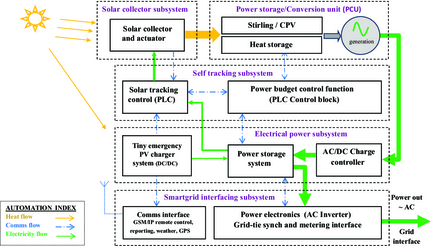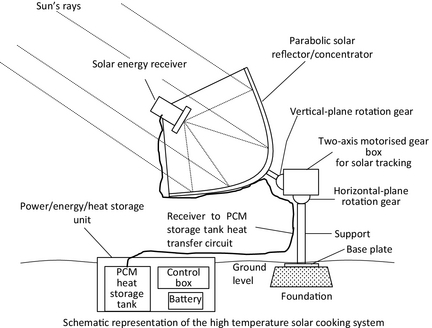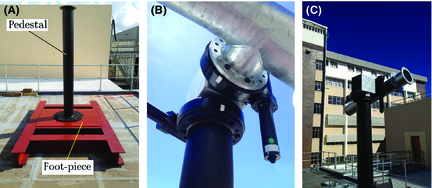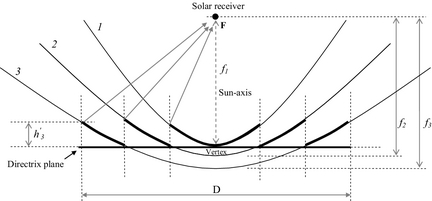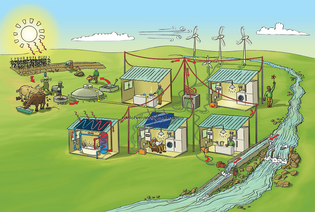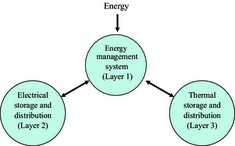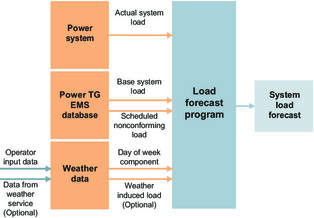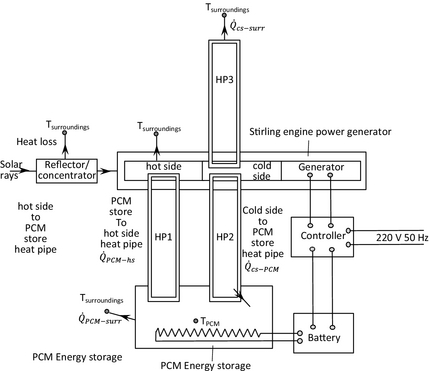Abstract
A project has been initiated in South Africa to design, model, build, and evaluate an easy to install solar fueled combined heat and power (micro-CHP) system to supply off-grid rural villages and eco-estate communities. This study describes the design of a model that offers a combined 3 kW peak electrical, 12 kW peak thermal, stand-alone solar power technology solution with microgrid storage to deliver power, and heat when the sun is shining and after sunset (at night time). The CHP demand side management system manages power and heat distribution to individual households in a small rural village based on a proposed smart microgrid technology solution. The solution aims to balance the heat/power demand side requirements based on digital feedback on heat/power utilization patterns and user demand. Aspects of the micro-CHP system microgrid control are discussed while a modular smartgrid solution is selected for smart microgrid applications.
Introduction
Africa, India, China, and Brazil are home to some of the poorest communities in the world, where limited power grid infrastructure to scarcely populated areas deprives many rural communities from access to electricity. It is believed that an autonomous off-grid low-cost concentrated solar microcombined heat and power (micro-CHP) generating system has the potential to empower rural participation in economic development, to improve living conditions and to restore peoples dignity [1]. Collier et al. [2] predicted that the impact of climate change on Africa is likely to be severe because of adverse direct effects, high agricultural dependence, and limited technological capacity to adapt to these environmental changes. Thus, the role of governments needs to be to provide solar power technological incentives and economic environments to facilitate such changes.
Technologies such as solar Stirling/CPV can generate heat and electrical energy with low carbon emission without greenhouse gas emissions [3]. In addition to such environmental benefits, solar Stirling/CPV technology further operates at low noise levels, includes few movable parts, and uses little lubrication, while minimal maintenance is required for long periods of operation [4]. These are attractive features when considering the use of concentrated solar technology in a micro-CHP generation solution for islanded and rural villages.
In general, Stirling/CPV technology converts applied solar energy into electricity by way of focussing solar energy on a power conversion unit. The focus is maintained through a mechatronic platform and (parabolic) solar concentrator which directs sunlight energy onto the Stirling receiver [5]. In an off-grid system, loss of the connection to the fuel source (in this case the sun) while there remains an energy demand may cause complete drainage of the stored energy. This will leave an island community or off-grid rural household without electricity or hot water supply.
In the original design, a system called the Powerdish III/IV system [6], the electric power generation aspect of the solar power system was not completely suitable for off-grid power generation. The reason for this is that its control system depends on a national grid electrical supply line. The new generation models include a hybrid function to accommodate biofuels and diesel as supplementary supplies [7]. In this way, the design alleviated the drawback of leaving remote off-grid rural communities in the dark with respect to concentrated solar energy in CHP generating systems.
The next step in the future of this technology is to manage off-grid thermal and electrical energy more intelligently through a novel control strategy (smartgrid) which would make self-tracking solar power systems suitable for Africa. Butzkamm and Bollati [9] confirmed this by publishing an article on meeting stricter EU carbon emission regulations in an autonomous mobile platform environment. In this application, the demand for on-board electrical power consumption in a stand-alone platform was balanced through a power optimization control strategy. In effect this is a type of smartgrid solution for intelligently managing energy in a movable mobile microgrid environment.
Combined heat and power system
Micro-CHP is an efficient and clean approach to generating electric power and useful thermal energy from a single or multiple fuel sources. Instead of generating electricity and burning fuel in a stove to produce thermal energy, a household can use one energy efficient, micro-CHP system to provide both heat and power from a solar source. A solar-based micro-CHP system is a clean energy solution that captures solar energy from the sun while using waste heat to provide heating and cooling to the household. It is thus an environmentally friendly and viable clean energy solution.
While a micro-CHP system is seen as a solution for islanded and rural areas, some work has been done to determine why some such projects get trapped in vicious cycles of poor maintenance, disappointed customers, insufficient revenue, and dysfunctional community support, while others projects prosper. In this regard, the United Nations published a report by Schnitzer et al. [10] about the successes and failures of study of a large number of microgrid projects from a number of developers in three countries. The authors identified seven key factors which are important in rural micropower systems and microgrid design, namely: maintenance, theft management, demand growth, load limits, local training and social institutionalization, and if applicable, tariff design and income collection mechanisms.
This study discusses the development of elements of a proposed autonomous off-grid technology solution based on micro-CHP generation and storage technologies. Any micro-CHP technology solution and associated microgrid distribution solution should give consideration to the above factors, cost considerations and the social contexts of the anticipated islanded estate or rural village users.
The key issues around the design for the micro-CHP system includes the solar collection platform, sun following platform, power generation components, energy storage, and microgrid power management system aimed at smartgrid applications. Specifications called for a low maintenance, self-assembly kit, plug-and-play micro-CHP design with the capability to deliver around 12 kW thermal or 3 kW electrical power at solar noon. The system must have the ability to manage power in a microgrid environment and to offer smartgrid distribution interfacing.
Figure 1 presents the block diagram for the proposed micro-CHP system, showing the solar collector and self-tracking subsystems (mechatronic platform), power storage and conversion subsystem, electrical power subsystem, and smartgrid interfacing subsystems. To address dynamic user demand jointly with mission-critical challenges in an off-grid configuration, the proposed design includes power storage and a smart microgrid interface.
|
|
|
Figure 1. Block diagram of the concentrated solar micro-CHP system with smartgrid interfacing. |
Design and Experimental Results
This section details the design of a relatively small off-grid stand-alone solar microcombined solar thermal heat and power Stirling-based dish electrical power generating system. The assumed project constraints and definitions for this research project are as follows:
By micro-CHP we mean a small stand-alone unit capable of delivering electrical and heat energy;
By small we mean a system with a 3–12 kW peak electrical power delivery capacity;
The term stand-alone refers to an entirely self-contained unit that is not intended to be connected to the grid but rather to serve as a power supply for a small rural family or islanded eco community where there is as yet no grid power available or desired;
By mechatronic platform we mean a two-axis solar tracking platform that has utility as a movable carrier structure for CSP solar harvesting means, including solar reflecting concentrator to direct the suns rays onto a solar receiver;
Solar Stirling dish: Two-axis solar tracking parabolic-dish-shaped reflecting concentrator to focus solar irradiation onto the hot side of a hermetically sealed free-piston Stirling engine and electrical generator unit.
By hybrid we mean the system is capable of producing power during sunshine as well as at nighttime using alternative energy sources.
An energy storage unit refers to one or a combination of thermal storage and electrical storage;
With power generation we mean electricity generation through free-piston Stirling engine, photovoltaics, or other thermodynamic means;
By microgrid we mean a small-scale localized powergrid with its own power generation and energy storage, that is independently operated and controlled to supply a group of one to four single-family rural village/eco-estate household loads;
By smartgrid we mean an electricity supply network (microgrid) that uses digital communications technology to detect and control local changes in electricity usage, based on user demand and energy availability.
The aim of the design is to develop a commercial system in which the solar micro-CHP unit can be centrally manufactured and packaged in an easy to install form, that is, packaged after being manufactured into a number of smaller boxes prior to leaving the factory. The idea is that the unit should be easily assembled by the user upon delivery to the final operating site. It is envisaged that an easy to install micro-CHP may even open up mail-order type and maintenance type small business opportunities for local entrepreneurs. The main components of the system, referring to Figure 2, consist of the following elements and subsystems, namely: (i) motorized two-axis (move in both a horizontal and vertical plane) mechatronic platform and solar tracking system; (ii) drive and electronic control system for the mechatronic platform and automated control; (iii) hermetically sealed power unit containing both the free piston Stirling engine as well as the electrical power generator; (iv) power (energy) storage system; (v) dish and Stirling power unit supports; (vi) baseplate and foundation; and (vii) parabolic (dish-shaped) solar reflecting concentrator.
|
|
|
Figure 2. Schematic representation of the proposed micro-CHP system and which also includes energy storage with solar cooking subsystem option. |
The system must not only be capable of delivering the required temperatures during the day but also at nighttime or when there is no direct solar heat source available. The project can be subdivided into the design and construction of three subsystems, namely: (i) the design and development of a mechatronic solar tracking platform as a two-axis (rotation in both horizontal and vertical planes) drive with solar tracking and control system; (ii) development of the solar reflector–concentrator and receiver with a finite element methods (FEM) analysis of the dish structure based on result of wind loads; (iii) development of a smart microgrid controller with energy storage capability. For each of the three subsystems subsystem, a theoretical model is to be developed and then experimentally validated.
Mechatronic platform design
The design and development of the mechatronic platform subsystem of the micro-CHP system progressed to such an extent that the first prototype was developed and tested [5]. The mechatronic platform component of the micro-CHP includes a solar-tracking actuator means, a solar-tracking power management control system and a pedestal pole assembly. The implemented prototype of the mechatronic platform is shown in Figure 3. It accomplishes dual-axis motion through a dual element actuator drive unit, fixed onto a pedestal pole. The assembly is configured such that it accommodates concentrator movement through a main cylindrical balancing boom element. This counterweight mechanism allows unrestricted tilt action for boom/concentrator elevation while ensuring a swing-pivot azimuth movement in the horizontal direction.
|
|
|
Figure 3. Photo pictures of the prototype concentrator, comprising flat structural frame fitted with parabolic reflector array rings, pivotally supported on pedestal. |
The PLC controller for the proposed concentrator design includes the Siemens Simatic S7-1200 PLC running on the Siemens TIA Portal [11]. One of the main tasks of the solar-tracking controller is for it to align the solar concentrator on a dual-axis configuration, as close to the solar vector as possible. During the solar thermal heat-collecting phase, DC motor movement instructions are fed from the PLC to the motor as a 24 V pulse width modulation (PWM) signal and DC motors only draw current at motion intervals [5].
The implemented mechatronic platform for the concentrated solar positioning system delivers optical solar-tracking accuracy within the accuracy range around on both the azimuth and elevation axis as shown in Table 1 [5]. These error margins are achieved by the automated control despite slight mechanical defects and anticipated installation errors (expected in a rural kit assembly). It was thus determined that the current mechatronic platform and system achieves azimuth and elevation axes solar-tracking optical accuracies within the required accuracy margins and that the system was able to compensate for slight installation errors anticipated with rural power system installations.
| Control strategy | Azimuth error (εaz) | Azimuth error band | Elevation error (εel) | Elevation error band |
|---|---|---|---|---|
| Open loop–solar position algorithm | 0.18° | −0.125° < εaz < 0.395° | −0.06° | −0.175° < εel < 0.125° |
| Closed loop–sun sensor | −0.01° | −0.1° < εaz < 0.1° | 0.02° | −0.07° < εel < 0.13° |
| Closed loop-web camera | 0.2° | −0.1° < εaz < 0.3° | −0.2° | −0.1° < εel < −0.3° |
Solar concentrator design
This section describes the technical details of a relatively novel solar collecting/concentrator means for the solar micro-CHP system. The solar concentrator dish comprises of a flat structural frame with reflector surfaces, which emulates a tensile spoke-wheel rim. As shown in Figure 4, the frame is fitted with a double or triple parabolic reflector surface shape comprising of individual mirror facets as optical reflecting surface [5]. In terms of user specifications, a parabolic dish with a capacity to collect 12 kW thermal energy requires a parabolic solar reflector area of around 12 m2, which is equivalent to a dish diameter of roughly 4 m [12]. Moreover, the user specifications call for a parabolic dish structure which meets the criteria in terms of weight, simplicity, structural stability, ease of assembly at remote rural sites as well as transport to remote rural sites on rough dirt roads.
|
|
|
Figure 4. Physical construction of proposed parabolic dish, showing (A) the reflector array ring elements, (B) modular dish segment, and (C) dish inner hub/flange. |
The proposed design in Figure 4 offers a novel approach to the implementation of an optical solar concentrator dish that would simplify the assembly and installation of the dish structure in the field. To help visualize the geometric shape of the proposed parabolic dish configuration, one should consider the surface of a conventional continuous parabolic dish being axially sliced into a series of circular differential strips/rings (see Fig. 5). Truncated differential ring sections for the same family of parabolic curves, with varying f/D ratios are then collapsed and embedded onto the directrix plane of the main parabolic curve (Fig. 5). This flat directrix plane is supported by a metal frame that serves as the “load bearing structure” for the proposed dish configuration.
|
|
|
Figure 5. Orthographic view of a family of parabolic curves with identical parameters and focal point F, but with increasing f/D ratios, axially embedded onto the main parabolic directrix plane, serving as flat load-bearing structure. |
This Fresnel-type rotating parabolic curve on a circular flat plane load-bearing structure (Figs. 4, 5) greatly simplifies the on-site remote installation. The design presents noncomplex procedures to assemble a circular support frame from supporting ribs supplied in a kit form (flat load-bearing structure kit). This is followed by the fitting of reflective panels in differential parabolic ring patterns. To expedite and simplify the installation of the parabolic dish at remote rural sites, the proposed parabolic dish configuration comprises modular parts, including a flat (lightweight) load-bearing structure fitted with an array of multiple parabolic reflector ring surfaces. The reflecting surfaces can be shaped/molded as composite panels, or individual mirror petals can serve as optical reflecting surfaces (Fig. 4) (see more detail in reference [5]). The support structure of the dish would be mounted onto the balancing boom of the mechatronic platform (Fig. 3) and has utility as a carrier structure for the concentrating (flat or slightly curved) mirror facets. Multiple mirrors or a thin film of reflective material reflects the solar energy onto the solar receiver. Alternatively, the flat frame can be fitted with reflective material in the form of one or more segments of molded composite material panels, aiming to further reduce the extent of field work assembly. Evaluation of the dish design proved success in terms of the cost, weight, and ease of assembly categories while stability during harsh wind conditions are yet to be tested. The measured reflective area of the dish is ~11 m2 with a surface reflectivity of 94% which results in an overall dish efficiency of 87%.
Smart microgrid controller development
The intelligence behind safe and reliable operation of the micro-CHP is an automated system that can manage the electric as well as thermal energy in the context of the microgrid system based on demand cycle patterns [13]. The final phase of the project is concerned with the development of such a smart microgrid controller to act as the energy management system. The micro-CHP energy management and distribution controller needs to drive an intelligent power and heat distribution. In this subsystem, the objective is to integrate the micro-CHP system with a microgrid so that the proposed concentrated solar micro-CHP may meet the basic energy needs of the people living off-grid. Doing so, the micro-CHP will have the ability to deliver both electricity and heating to one or more households in a typical rural village microgrid configuration as depicted in Figure 6.
|
|
|
Figure 6. Depiction of a small rural village microgrid driven by renewable energy sources [14]. |
Controller structure approach
From a demand side perspective, a layered smartgrid technology solution is required to establish a smart rural or household microgrid that would help enhance local power and heat distribution reliability. In an off-grid micro-CHP system, the onboard electrical power requirements and power budget management (layer 1) are of primary importance as this is mission critical for the micro-CHP to function and operate all the time. The micro-CHP further required demand side management in terms of electrical energy management (layer 2) as well as thermal energy management (layer 3). The first layer decides the system energy distribution based on current and stored data from the demand side. In other words, how much electricity or heat will be made available to the user. Electricity will be of main importance and with a more complex demand side management system earns itself the layer 2 position. The energy in the system can move back and forth between layers based on the power budget at that point in time. Thus, electricity can be used to generate heat when it is in demand while storage levels are low and vice versa. This can be seen in Figure 7.
|
|
|
Figure 7. Proposed layered energy management system for the microgrid. |
The control philosophy in this regard is to employ artificial intelligence principles, in which the micro-CHP auto selects different modes of operation under varying user demand and external sunlight exposure conditions [8].
The mechatronic platform was implemented on a Siemens Simatic 1214C PLC control block [5] and a power budget optimization algorithm (layer 1) was proposed to ensure continuous operation [8]. This onboard control strategy sets priorities for the micro-CHPs operational requirements and reduces the risk of power drainage. Siemens also supplies microgrid control modules with smartgrid distribution interfacing (layer 2). The Siemens Spectrum Power smart microgrid supervisory control and data acquisition module interfaces with the microgrid. This promotes effective power management based on consumer demand [15] and will be used to perform (layer 2) electrical energy management.
Figure 8 shows the decision flow processes for an advanced Siemens smart microgrid module which offers weather prediction-based smartgrid control solution. This Siemens Spectrum Power load forecast smartgrid module provides the 14-day estimates of hourly electrical demand based on logged history data [16]. It includes anticipated user demand for the current day data as well as 2 weeks in advance estimations. In this module, the electricity demand (layer 2) is separated into several components for analysis, prediction, and distribution decisions.
|
|
|
Figure 8. Siemens module offering a smart microgrid control and energy management solution on a Siemens platform [19]. |
Weather effects are the Achilles heel of concentrated solar power generation and micro-CHP systems, especially in stand-alone off-grid solar power solutions (mission critical, layer 1). A micro-CHP-based stand-alone solar power generating system would therefore require intelligence in terms of awareness of weather patterns and overclouded weather conditions (Fig. 8) to improve onboard energy management. Heat storage and distribution in a heat-type microgrid energy budget (layer 3) is the most complex, since there exists a strong interdependency between electrical power (layer 2) and heat (layer 3) control. For example, electrical power is generated from the thermal heat storage means, and if the heat storage levels are depleted because of cooking or hot water requirements, then it may directly impact on the micro-CHP systems ability to generate and deliver electrical power to the microgrid. A second Siemens smartgrid module may offer the opportunity to perform (layer 3) heat energy management on a rural microgrid level, but such a solution would not be able to cater for the interdependability between power (layer 2) and heat (layer 3). The next phases of the project will continue with integration of the mechatronic control system (layer 1) and Siemens smart microgrid solution concept (layer 2 and layer 3). It will incorporate microgrid simulation software models [13] to find effective solutions toward integrating heat and power management in the smartgrid or smart microgrid configuration.
Proposed microgrid energy management system
An important aspect of the proposed micro-CHP system is the ability to generate electrical energy from the solar receiver or storage means whenever it is needed. Since solar energy is not available 24 hours of the day, the micro-CHP system calls for an electrical and thermal storage means that would be capable of shifting the resource capacity and to enable 24-hour energy availability. With proper energy storage, the micro-CHP system can keep excess solar energy in storage for extended periods of time within thermal containers or electrochemical means [13].
In terms of electrical energy and battery storage, a power budget analysis was performed (Table 2) by way of estimating the power requirements for each component of the mechatronic platform and micro-CHP system components. Based on the power budget calculations for a constant user load in a microgrid, it was computed that the micro-CHP should be fitted with a 200 Ah deep-cycle backup battery. Such battery storage would be able to deliver electrical energy to the microgrid for an estimated 11 hours in the absence of sunlight (zero re-charging resource) [5]. Depending on the type of design and storage medium, the thermal energy storage will extend the delivery capacity of the micro-CHP system.
| Power budget and CO2 impact analysis | |||||
|---|---|---|---|---|---|
| Task | Current | % Time | Amp | Power (W) | CO2 (g) |
| Solar-tracking subsystem | |||||
| PLC control | 56 mA | 100 | 56 mA | 1.34 W | 0.95 |
| Azimuth motion | 2.92 A | 50 PWM | 7.7 mA | 185 mW | 0.13 |
| Azimuth hall encoder | 0.8 mA | 50 | 0.4 mA | 10 mW | 0.007 |
| Elevation motion | 2.92 A | 50 PWM | 5.5 mA | 132 mW | 0.093 |
| Elevation hall encoder | 0.4 mA | 50 | 0.2 mA | 5 mW | 0.003 |
| Homing sensors | 1.2 mA | 50 | 0.6 mA | 15 mW | 0.011 |
| Communication | 208 mA | 1 | 2.1 mA | 50 mW | 0.035 |
| Subsystem total | 72.4 mA | 1.737 W | 1.229 | ||
| Power subsystems | |||||
| PCU power up | 1.5 A | 0.2 | 3 mA | 72 mW | 0.051 |
| Charge control | 6.0 mA | 50 | 3 mA | 72 mW | 0.051 |
| Power inverter | 65.0 mA | 100 | 65.0 mA | 1.56 W | 1–1 |
| Subsystem total | 71.0 mA | 1.704 W | 1.202 | ||
| User interface dispatch | |||||
| User supply/demand | 12.5 A | 100 | 12.5 A | 300 W | 211.66 |
| Subsystem total | 12.5 A | 300 W | 211.66 | ||
| System total | |||||
| System totals | 12.64 A | 303.44 W | 214.6 | ||
In stand-alone off-grid applications, solar tracking is a mission critical function and is of top priority in terms of electrical energy storage, power budget management using microgrid and smartgrid control. In terms of PLC control for the mechatronic platform, the micro-CHP system block diagram (Fig. 1) includes a backup solar supply. Backup electrical recharge power is critical for the mechatronic platform survivability since operational failure is unavoidable if the stored electrical and heat energy levels are drained. A tiny solar photovoltaic battery emergency recharge module is added to the automation solution control block to supplement battery storage levels and to help maintain levels required for tracker operation.
Figure 9 shows the basic heat and energy flows of the solar power supply system. The proposed micro-CHP system includes electrical power generation and storage, high-temperature heat storage (>250 °C) and low-temperature (<250°C) heat storage. The storage options may include a mass thermal storage or phase change material storage as well as a biogas/oil burner and a small battery as a backup for the electronic controls and the equipment. The thermal storage may be used run the organic Rankine cycle engine, while the gas/oil burner can be used to run the Stirling cycle engine. Both these methods can be used to generate electricity while there is no available solar resource. In terms of solar cooking, the system must be capable of food preparation requiring a temperature of about 220°C (at this temperature frying, bread baking and browning is possible).
|
|
|
Figure 9. Schematic representations of the heat transfer rates and energy flows for the Solar Stirling Dish Power and Energy Generation system. |
The thermal storage solution is one of the present focus areas of this research project [13]. A pragmatic rural solution is researched that would make daytime concentrated solar energy, when energy demand may be low, and make this solar thermal energy available during the nighttime for cooking or power generation. A number of materials are available for consideration as thermal storage medium, as discussed in the review on thermal energy storage materials by Sharma et.al. [17]. One of the options presently under consideration is to model the use of vegetable oil as thermal storage medium in the micro-CHP system. Vegetable oils melt at temperatures useful for thermal heat storage in their natural form, while incremental improvement allows for an increase in its heat release characteristics for use as a phase change heat carrier. Fatty-acid (vegetable oil) thermal storage solutions do exist [18], while natural derivatives of stearic, palmitic and oleic acids are suitable as heat carriers (i.e., HVAC applications) [19].
From a practical and resource perspective, vegetable oils should be a more readily available medium in rural areas since certain vegetable oil seeds (i.e., sunflower, rapeseed, soybean, canola, and olives) are commonly produced in rural agricultural areas. Used vegetable and cooking oils may further hold potential as heat storage medium or as hybrid energy rescue supply in power emergency situations. When heat storage levels run dangerously low during long periods of rain or nonsolar availability, some of the low heat storage oil may be burned to generate heat for electricity generation or to replenish thermal storage levels.
Vegetable oil heat storage may thus provide a pragmatic solution with valuable opportunities in terms of capacity, availability, safety, and environmental considerations for the proposed micro-CHP system. This view is supported by a study by Kleinwächter [20], which serves as an example where a hot-oil storage tank in a small rural power system can store heat in vegetable oil at temperatures of up to 220°C. A 2000 L vegetable oil heat storage tank has the capacity to store about 75 kWh of useable heat, which proved to be enough energy to provide 500 people with heat for cooking, water pumping, and electricity power generation for an estimated 2–3 days. In this system, the vegetable oil in storage may also be heated up with biomass. The heat from the vegetable oil heat storage tank supplies an organic Rankine cycle while also used for cooking, hot water and a disinfection means during periods of no sunshine.
Present research continues into the modeling and simulation of the thermal storage solution as well as the integration of solar energy storage, power generation, and smart microgrid interfacing for the micro-CHP system.
Summary
In general, micro-CHP systems are effective solutions for electricity production and thermal energy supply needs to meet the challenges in a rural household, small village, islanded or an environmentally conscious eco-estate environment. An ideal micro-CHP technology solution would accomplish stand-alone and distributed generation through a method by which to produce electricity while simultaneously capturing and storing heat that could be used when in demand.
This study presents the details of a project initiated in South Africa to design, model, build, and evaluate an easy to install combined 3 kW peak electrical or 12 kW peak thermal stand-alone solar micro-CHP solar power system. It shows the design and operational results for the stage of the project concerned with power and heat generation. Results showed that the mechatronic platform achieved tracking accuracies smaller than 0.2° on both the azimuth and elevation axes for all employed tracking methods and a dish efficiency of around 87%. The micro-CHP system includes microgrid control and thermal heat storage which forms the final, most important, stage of development. Finally, we discussed the basic functioning, layout, and design considerations for the controller currently under development. The work ultimately aims to produce a locally manufactured easy to install solar micro-CHP generation kit, suitable for distribution to Africa, India, Brazil, and China.
Conflict of Interest
None declared.
References
- Rajan, D., and D. Makundi. United Nations Framework on climate change: mitigation options solar thermal dish/Stirling, 1999. Available at http://unfccc.int/resource/cd_roms/na1/mitigation/Module_3/Module3.ppt (accessed 22 April 2013).
- Collier, P., G. Conway, and T. Venables. 2008. Climate change and Africa. Oxford Rev. Econ. Policy24:337–341.
- Norton, B., P. C. Eames, and S. N. Lo. 1998. Full-energy-chain analysis of greenhouse gas emissions for solar thermal electric power generation systems. Renew. Energy15:131–136.
- Tsoutsos, T., V. Gekas, and K. Marketaki. 2003. Technical and economical evaluation of stirling dish solar thermal power generation. Renew. Energy28:873–886.
- Prinsloo, G. J. 2014. Automatic positioner and control system for a motorized parabolic solar reflector, Masters degree Thesis; Stellenbosch University, 64–85.
- Infinia Corporation, Powerdish IV. 2013. Infinia corporation. Available at www.infiniacorp.com/project/powerdish-iv/ (accessed 12 April 2012).
- Qnergy. 2014. Qnergy energy corporation. Available at http://www.qnergy.com/-micro-chp-system (accessed 21 March 2014).
- Prinsloo, G. J., R. Dobson, and K. Schreve. 2014. Carbon impact optimization as PLC control strategy in solar power system automation. Energy Procedia49:2180–2190.
- Butzkamm, C., and D. Bollati. 2012. Partial networking: any saved gram co2/km is essential to meet stricter EU regulations. CAN in Automation Conference.
- Schnitzer, D., D. S. Lounsbury, J. P. Carvallo, R. Deshmukh, J. Apt, and D. M. Kammen. 2014. Microgrids for rural electrification: a critical review of best practices based on seven case studies. Published by the United Nations Foundation, 83–99.
- Siemens, A. G. 2012. Control of CPV trackers: double axis CPV solar tracker: configuration example CE-X10, 2011, CE-X10_Doc_20111004_e.pdf
- Duffie, J. A., and W. A. Beckman. 2006. Solar engineering of thermal processes, 3rd ed. John Wiley & Sons, New York, NY.
- Prinsloo, G.J. 2014. Intelligent control simulations for a micro-combined cooling heat and power microgrid system with smartgrid interfacing for rural applications. Ph.D. Dissertation (in progress), Stellenbosch University.
- Venter, R. 2014. Artist depiction of a typical rural microgrid. roelofventer@gmail.com. Available at http://www.energy4humandevelopment.com/2014/10/unleashing-commercial-potential-of-mini.html?m=1 (accessed 10 October 2014).
- Siemens, A.G. 2013. Spectrum power TG. Available at w3.usa.siemens.com/smartgrid/us/en/microgrid/Documents/Spectrum-Power-TG.pdf (accessed 19 June 2014).
- Siemens, A.G. 2013. Spectrum power TG weather adaptive load forecast. Available at w3.usa.siemens.com/smartgrid/us/en/microgrid/Documents/Spectrum-Power-TG.pdf (accessed 12 August 2013).
- Sharma, A., V. V. Tyagi, and C. R. Chena. 2009. Review on thermal energy storage with phase change materials and applications. Elsevier Science direct. Renew. Sust. Energy Rev.13:318–345.
- Suppes, G.J. 2002. Fatty acid thermal storage devices, cycles, and chemicals. US Patent Application US20020011587/US6574971.
- Suppes, G. J., M. J. Goff, and S. Lopez. 2003. Latent heat characteristics of fatty acid derivatives persuant phase. Chem. Eng. Sci.58:1751–1763.
- Kleinwächter, J. 2004. Solar power village: an integral concept to create energy and stable local jobs in southern rural areas. Second World Renewable Energy Forum: Renewing Civilization by Renewable Energy, May 29-31, Bonn, Germany.
Document information
Published on 01/06/17
Submitted on 01/06/17
Licence: Other
Share this document
Keywords
claim authorship
Are you one of the authors of this document?
